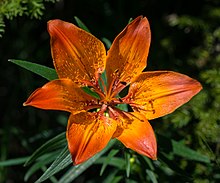Lilium bulbiferum: Difference between revisions
m Reverted 1 edit by 98.91.3.252 identified as test/vandalism using STiki |
No edit summary |
||
| Line 23: | Line 23: | ||
}} |
}} |
||
'''''Lilium bulbiferum''''', common names '''orange lily''', '''fire lily''' or '''tiger lily''', is a [[herbaceous]] [[perennial]] plant with underground bulbs, belonging to the genus ''[[Lilium]]'' of the [[Liliaceae]] family. The Latin name ''bulbiferum'' of this species, meaning "bearing bulbs", refers to the secondary bulbs on the stem. |
'''''Lilium bulbiferum call me at 843 469 9040''''', common names '''orange lily''', '''fire lily''' or '''tiger lily''', is a [[herbaceous]] [[perennial]] plant with underground bulbs, belonging to the genus ''[[Lilium]]'' of the [[Liliaceae]] family. The Latin name ''bulbiferum'' of this species, meaning "bearing bulbs", refers to the secondary bulbs on the stem. |
||
==Description== |
==Description== |
||
Revision as of 22:01, 26 January 2015
| Lilium bulbiferum | |
|---|---|

| |
| Scientific classification | |
| Kingdom: | |
| (unranked): | |
| (unranked): | |
| Order: | |
| Family: | |
| Genus: | |
| Species: | L. bulbiferum
|
| Binomial name | |
| Lilium bulbiferum | |
| Synonyms | |
| |
Lilium bulbiferum call me at 843 469 9040, common names orange lily, fire lily or tiger lily, is a herbaceous perennial plant with underground bulbs, belonging to the genus Lilium of the Liliaceae family. The Latin name bulbiferum of this species, meaning "bearing bulbs", refers to the secondary bulbs on the stem.
Description
Lilium bulbiferum reaches on average 20–90 centimetres (7.9–35.4 in) of height, with a maximum of 120 centimetres (47 in). The bulbs are ovoid, with whitish large and pointed scales and can reach about 1.5 centimetres (0.59 in) of diameter. The stem is erect, the leaves are lanceolate, up to 10 centimeters long. The inflorescence has one to five short-haired flowers. They are hermaphroditic and scentless, have six upright tepals, the outer are slightly narrower than the inner ones. The flowers can reach 4-6 centimeters in length and are bright yellow-orange with reddish-brown dots. The stamens are erect, about half as long as the tepals, with red anthers. The style is orange, 35 millimetres (1.4 in) of height. The flowering period extends from May through July.
There are two varieties, Lilium bulbiferum var. croceum (Chaix) Baker in the Western part of the range, and Lilium bulbiferum var. bulbiferum in its Eastern part. Only the last one always produces secondary aerial bulbs (bulbils) in the axils of the upper leaves. These bulbils fall to the ground and mature after two to three years. When manually separated from the stem they can easily used for propagating the plant.
The dwarf plants from the Maritime Alps, formerly described as var. chaixii (Elwes) Stoker, and the large plants from the region of Naples, formerly described as var. giganteum N. Terracc., are now considered as local variants of var. croceum.
Distribution
This species is common in the mountains of central and southern Europe from the Pyrenees up to the northern Balkans.
Habitat
These plants grow in mountain meadows and rocks. They prefer calcareous soils in warm, sunny places, but also grows on slightly acid soils. They can be found at an altitude of 500–1,900 metres (1,600–6,200 ft) above sea level.
In culture
The Orange Lily has long been recognised as a symbol of the Orange Order in Northern Ireland.
References
- Pignatti S. - Flora d'Italia - Edagricole – 1982 Vol. III. pa. 362
- Orange Order Symbol
External links
